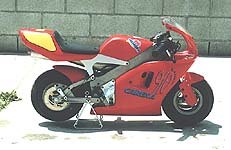Bike Review: Polini 910 Carena - Motorcycle.com
Los Angeles, May 13, 1999 -- Motorcycle racing, like so many other professional sports, has always been just out of reach for most people to consider themselves active participants. In order to solve this dilemma many of the world's premiere motorcycle racing organizations have developed classes that would, in theory, promote cheap racing. Unfortunately, in practice, they do not. Most of the expenses involved with the "cheap" classes of racing involve procuring parts and transportation. The cost of a good bike may not be as much, but the expense required in maintaining enough spare parts and tools for a full season of racing is ridiculous, while the cost of transportation is just as expensive. What would happen if the bikes were reasonably priced and the cost of specialized transportation was almost
Basically, pocket bikes, also known as minimotos, are not mini-bikes in the traditional sense. They are miniature GP racing motorcycles, accurate in proportion to GP bikes and include many of the same component materials such as disc brakes, alloy and billet aluminum cast perimeter frame and swingarm. They are so small they many be perfect as a decoration piece. However, pocket bikes are manufactured to be ridden.
Upon removing the Carena from its box, we were required to install the footpegs and tighten the clip-ons to the forks. After that we had to cook up some two-cycle engine food and feed it into the empty tank. We took a last look over the bike and, seeing no potential for trouble, we pulled the starter cord. Although the manual said you only have to pull gently, we had to give it relatively hefty pull but before being rewarded with the distinctive sound of a two-stroke engine waiting to be driven.
When a turn comes up, throttle back and squeeze the front and rear disk brakes. Much like the throttle, the brakes are extremely sensitive. However, they were well modulated, not grabby. Next, spot your line and begin to countersteer. At this point you notice how suspension can greatly affect the handling of the bike. The bike is beginning to wallow and you're madly trying to readjust your line in hopes of lessening the turbulence. Unfortunately, that only makes it worse. The correct procedure is to ride it out with a liberal dose of throttle. The little Polini bike can take a fierce beating. Throttling out of the corner, the front wheel lightens up and you do a cool, leaned-over-with-the-front-wheel-half-cocked wheelie. By the time the front wheel touches down, you're again hurtling along at 40 miles per hour, ready to begin the process one more time.
The styling is nice, sparking daydreams of riding a factory bike to victory in GP racing
Since you are so low to the ground, spills generally involve road rash, but be careful, 40 miles per hour still 40 miles per hour, and contact with the pavement will hurt. Also remember to wear your helmet. We're not trying to be namby-pamby but your head, at just about any speed, bouncing against the asphalt is gonna hurt. Besides, this is a micro-sized performance bike, not a wind-through-your-hair cruiser.
The front brake is generally pretty good, but it is also susceptible to fade. Also, the included owner's manual is not impressive. The text is translated directly from Italian, making it very difficult to read. We had a few other niggles: The welds that attach the clip-ons to the mounting hardware don't invoke much confidence and our test bike doesn't like to hold a smooth idle speed. Instead, it revs high enough to spin the wheel rather rapidly with the bike still on the included stand. This is probably just a simple carburetor adjustment problem rather than a problem with the bike. However, our bike would routinely dribble out a black, oily liquid from the tail pipe. Nevertheless, our little bike hauled sufficiently enough not to warrant a carburetor adjustment. Another problem we had was a leaking head gasket, although this may have been attributed to our over-exuberant riding styles more than anything else.
Leagues and classes are in the process of being formed in America, while the Europeans (Brits and Italians mainly) have already embraced pocket bike racing as a legitimate sport. In fact many top European riders have at one time raced pocket bikes. The Polini 910 Carena starts at $1304.21 USD. If you are interested you may contact East Coast Mini-Moto at (732) 542-5116 or check out their web site at http://www.motorcycle.com/cgi-bin/redirector?www.pocketbike.com for more information in regards to pocket bikes or pocket bike racing.
Specifications
Manufacturer: Polini-MotoriModel: 910 CarenaPrice: 04.21 (USD)Engine: air cooled, single cylinder two-stroke (liquid-cooled available)Compression ratio: 16.2:1Bore and Stroke: 36 x 39 mmIntake: reed valve in the crankcaseClutch: dry with centrifugal counter weightsDisplacement: 40ccFrame: alloy die-cast frame with double diagonal barHorsepower: 4.2 and 6.2 hp at the crankCarburetion: single Del 'Orto SHA 14 - 14Starting: pull start with self winding cableIgnition: ElectronicFuel capacity: 1.8 Liters (0.48 US gal)Front Tire: 90/80 - 5Rear Tire: 90/80 - 5Brakes: Single disc 122 mm (4.81 in), front and rearOverall Length: 965 mm (38.02 in)Overall Width: 250 mm (9.85 in)Seat Height: 380 mm (14.97 in)Colors: Red, White, Plum, Black, and Polini racing team colorsAvailable with bigger wheels for 6.2 hp model.
More by Motorcycle Online Staff
































Comments
Join the conversation